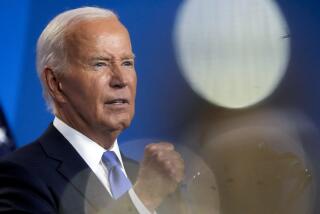For Clinton, Ducking a Fight Is Not the Right Way to Handle the Left
- Share via
Can this marriage be saved? More important, should it be saved?
Those are the questions swirling along Pennsylvania Avenue after House Democrats ended up throwing the crockery at President Clinton in the debate over “fast-track” trade authority earlier this month. Disputes among Democrats, of course, are as rare as snow in winter. But Clinton’s abandonment by nearly 80% of House Democrats on fast-track was messy even by those standards; even hapless Jimmy Carter never suffered as great a defection among fellow Democrats in Congress. Now relations between the White House and congressional Democrats are “just dark and ugly, and I don’t know how it gets fixed,” said one senior House Democratic aide.
Since fast-track collapsed, most of the press commentary has blamed Clinton for neglecting the concerns of House Democrats. There’s something to that: His meager support even among moderate Democrats shows that Clinton allowed the GOP to tilt the fast-track bill too far to the right.
But it’s a mistake to generalize from that tactical miscalculation to the broader conclusion that Clinton has run into trouble because he’s pursued too many causes opposed by Capitol Hill Democrats. The opposite is truer: Almost every time Clinton has altered his course to avoid a collision with congressional Democrats, he’s steered into a dead end.
Occasionally, congressional Democratic leaders have pointed Clinton in productive directions, such as when they insisted that he put his shoulder behind raising the minimum wage. More often, they have pushed Clinton to adopt positions that narrow his appeal while upholding party orthodoxy.
In 1993, the Democratic leaders convinced Clinton to scuttle congressional reform, and then resisted spending cuts in his initial deficit-reduction plan--which forced the plan to rely more on tax increases. (That amounted to wrapping it in explosives.) In 1994, House Democrats disastrously lobbied him to shelve welfare reform, and then larded his crime bill with liberal spending programs that the GOP exploited in derailing it that summer. Completing a rare triple botch, the House leadership then bottled up campaign finance reform. All of these errors--combined with Clinton’s own spectacular miscalculation on health care--fueled the GOP landslide in 1994.
The still-relevant lesson in all this was that Clinton and congressional Democrats do not share identical interests. Clinton inherited a party that had averaged just 43% of the vote while losing five of the six presidential elections before his nomination in 1992; his imperative has always been to formulate an agenda that broadens the Democrats’ appeal.
Democratic governors and senators have broadly supported Clinton’s course, largely because they must also assemble diverse coalitions to win their statewide campaigns. But most House Democrats run in safe seats amply stocked with reliable Democrats. Their first instinct is to preserve harmony within the existing Democratic coalition. That ensures regular conflict with a president focused on expanding the coalition. More schmoozing and stroking from the White House might help, but it wouldn’t eradicate that basic problem. It’s more structural than personal.
Clinton didn’t regain control of his presidency until he declared independence from congressional Democrats by offering his own balanced-budget plan in 1995. Hill Democrats howled in outrage. Yet Clinton’s decision allowed him to regain the upper hand in the fiscal struggle with the GOP (by changing the issue from whether to how to balance the budget) and paved the way for both his reelection and the bipartisan balanced-budget plan approved last summer.
In a way, the fast-track vote constitutes the bookend to that breakthrough. The success on the budget showed the power of an approach that triangulated Clinton between the two parties and advanced legislation through bipartisan coalitions. The repudiation on fast-track is a reminder that even a president committed to bipartisanship can’t afford to entirely ignore the priorities of his own party.
For the White House, the most immediate temptation may be to read the fast-track debacle as a reason not to pursue serious reform of Medicare and Social Security--initiatives that would probably pit Clinton against the same left-labor coalition that humbled him on trade. But the Democratic disaster in 1994 suggests that Clinton (not to mention Al Gore in 2000) could pay a high price for such caution. To sustain his gains with voters in the center, Clinton has to accept more conflict with the left--especially on a threshold issue like retooling entitlements for the aging of the baby boom.
Yet Clinton would be equally obtuse to disregard the rumbling in his backyard. Clinton’s problem isn’t that he’s challenging the left. That’s an occupational hazard of building a Democratic Party that can compete nationally. His problem is that he’s offering his base not much except challenge; he’s allowed his agenda to dwindle to the point where it contains very little that excites partisan Democrats.
Clinton might find his conflicts with the Democratic left easier to manage if he were simultaneously pushing causes that united his party. Ideas such as providing new federal funds for school construction, expanding access to quality child care and indexing the minimum wage to inflation (an idea Clinton endorsed in 1992) all have the potential to excite core Democrats without compromising Clinton’s centrist direction. Clinton’s embrace last week of a “patient’s bill of rights” marked a step in this direction, and more could come as the White House completes work on a joint 1998 agenda with Hill Democrats.
The left’s most persuasive critique of Clinton’s second-term agenda is not that it lacks commitment to Democratic principles; it is that it lacks “scale,” as Democratic consultant Bill Carrick puts it. The solution to that problem isn’t to duck conflict with Democrats. It’s to mobilize Democrats into larger battles that put the disputes in perspective. Clinton’s struggle to synthesize liberal and conservative priorities has always been turbulent: Conflict is the inherent condition of his presidency. Nothing would neuter Clinton more completely--nor more diminish his odds of permanently changing his party--than trying to avoid it.
More to Read
Get the L.A. Times Politics newsletter
Deeply reported insights into legislation, politics and policy from Sacramento, Washington and beyond. In your inbox twice per week.
You may occasionally receive promotional content from the Los Angeles Times.










